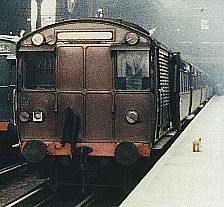
Suburban Electric Railway Association
Located at the COVENTRY ELECTRIC RAILWAY CENTRE, Rowley Road, Baginton, Warwickshire
Established
1996
The History Zone
History of North London DC Services
Part Two
The London Midland And Scottish Railway Era
1923 - 1947
Under the railway grouping of 1923, whereby all of Britain's railway companies were grouped together under the big four companies, the LNWR became absorbed as part of the London Midland And Scottish Railway (LMS). As already mentioned, it was under LMS management that the final part of the LNWR electrification scheme was completed in 1927. The LMS also set about repainting all the units into the LMS maroon livery.
A rare colour photo of an Oerkilon set in LMS maroon (archive)In 1927 the LMS also built extra three car units to cope with the increased demand from passengers that electrification had brought about. Again they were formed of a driving motor brake, trailer composite and driving trailer brake, but this time the passenger accommodation was in all compartment form, they were,like previous types, built at the Metropolitan Cammel works at Wednesbury. Traction equipment was provided by Metropolitan Vickers, which was owned by the American GEC group, thus these units became known as the 'GEC stock'. The total power of each motor coach was 1060hp.
Official LMS photo of a 'GEC' unit at Croxley Green depot (archive)The GEC stock lasted just a little longer than the Oerlikon units, the last ones being taken out of use in the early sixties.
The North London electric network settled down to everyday existence without change from the late 20s until the outbreak of World War II in 1939 when as a wartime economy measure the LMS had to reduce the number of services. These reductions involved the total withdrawal of LMS services on the routes between Willesden Junction and Earls Court and Kew Bridge. Neither service was reintroduced after the end of the conflict.
On January the 1st 1948 the LMS along with all the other railway companies were nationalised under the British Railways banner.


